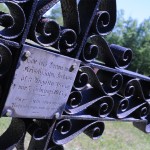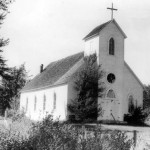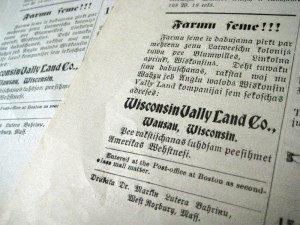Air as fresh as in a Kurzeme forest:
Lincoln colony in Wisconsin
The Lincoln colony began to develop not far from the cities of Bloomville and Gleason around 1897, when Latvian immigrants from the eastern USA began moving to this region.
According to the Amerikas Vēstnesis newspaper, brothers Ansis and Jānis Šteins from Philadelphia were among the first colonists. Fricis Amsters moved from Boston to Wisconsinin early 1898 to purchase land, and in a letter to Amerikas Vēstnesis encouraged others to do the same, saying life in Wisconsin would soon be as good as elsewhere. Another Latvian, G. Arders, who also moved close to Bloomville with his wife in 1898, wrote to the newspaper that life in Lincoln was pleasant, and that “the land is excellent, everything grows well, the air as fresh as in a Kurzeme forest”.
The publisher of Amerikas Vēstnesis , Latvian-Estonian priest Hans Rebane and editor Jēkabs Zībergs, provided a lot of support for the idea of the Lincoln colony. From October 1900 to 1903, an advertisement from the “Wisconsin Valley Land Company” offering to sell land in Lincoln, appeared in each issue of the newspaper. By 1902, about 100 Latvians already lived in the Lincoln colony, by 1905 there were around 200. Up to 1000 Latvians may have lived there in the heyday of the colony. However, not everyone found favourable conditions here, and not everyone was satisfied with the colony’s community or farming life. Some Latvians worked in the forests and then left Lincoln, journeying further to the nearest metropolis, Minneapolis, or elsewhere in America.
Urged on by Rebane, the Lincoln Latvians founded the Martin Luther congregation in August 1900 and purchased 40 acres (about 16 hectares) of land for a cemetery and other facilities. There was talk that a church would already be built in the cemetery territory in 1903; however, this only took place in 1906.
Workers and some political refugees from the 1905 revolution also joined the colony, and soon founded the Lincoln Social Democratic group. As the First World War broke out in Europe, emigration from the Baltic region diminished, and as a consequence Latvian immigration to America also decreased. Some versions suggest that the downward spiral of the Lincoln colony began at this time. Young people left to find their fortunes elsewhere, and married with people from other nationalities.
Religious services were still held in the church for a number of years, but in the 1960s it became clear that the community life of the colony had no future. The church was demolished and the building materials sold off, while the church bell was moved to the exile Latvian congregation’s church in Minneapolis. The land, excluding the cemetery territory, was sold in 1973 and the proceeds donated to the Gleason Luther Memorial Cemetery Association.

The Martin Luther congregation church has been demolished, but the cemetery remains. This is the first Latvian cemetery in the USA

A grave marker for Krišjānis Cielavs (1844-1914)

Martin Luther congregation church, 1960s





